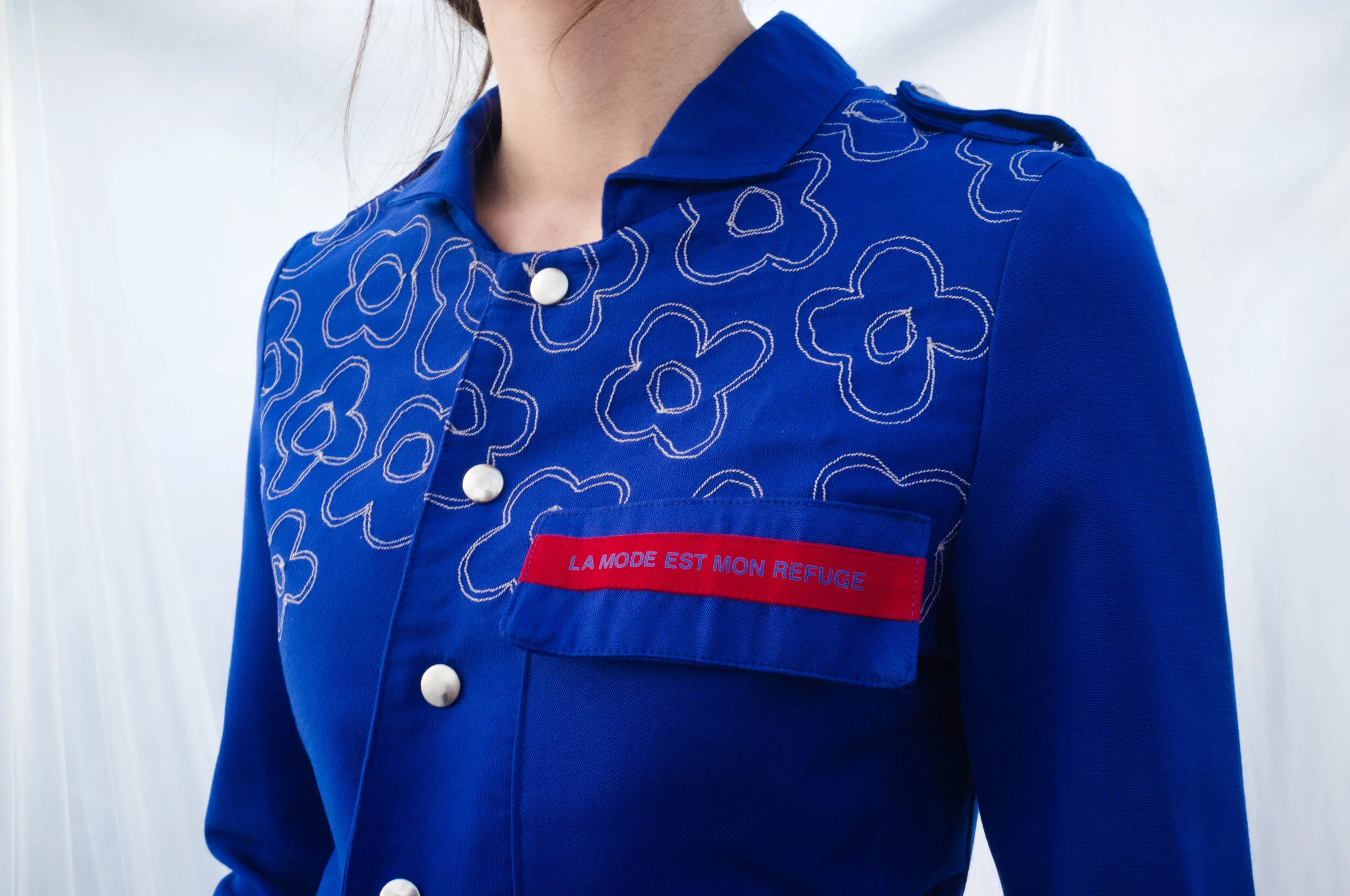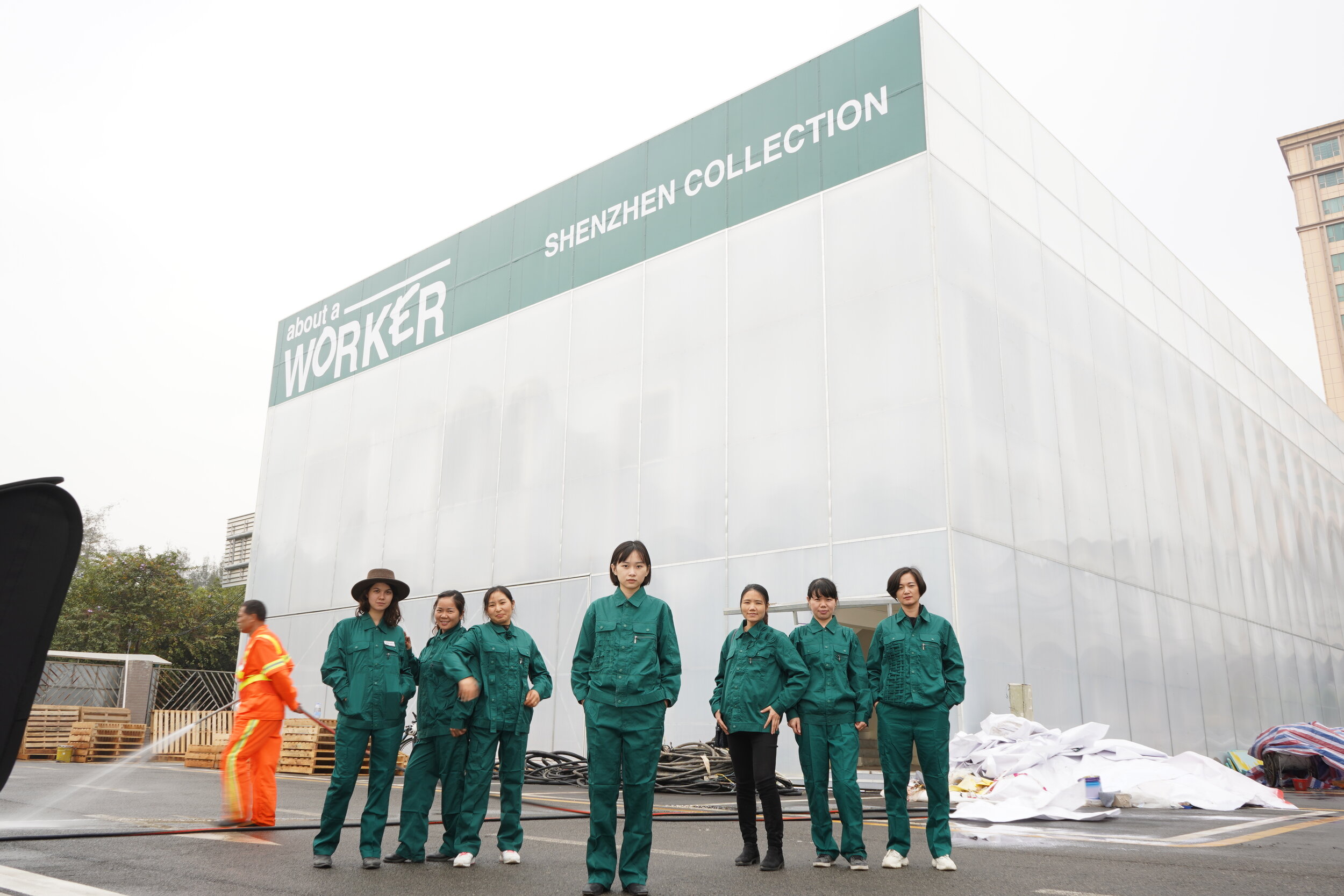ABOUT A WORKER,
designerS
October, 16th 2020
ENG
Founded in 2017 by Kim Hou and Paul Boulenger, ABOUT A WORKER is a design studio giving manufacturing workers the ability to become designers. Through an introduction to creative expression, workers design products inspired by their vision of the industry and personal stories, using design as a universal language. ABOUT A WORKER’s creations question and connect workers, designers, consumers in order to transform their context inclusively. Graduated in 2017 from the Design Academy of Eindhoven in the Netherlands, Kim Hou created ABOUT A WORKER as her graduation project: a platform to rethink the design industry of tomorrow. Through its complementarity with Kim’s artistic vision, Paul Boulenger has joined ABOUT A WORKER in 2017. Paul focuses on garment production methods by exploring current working conditions.
ITA
Fondato nel 2017 da Kim Hou e Paul Boulenger, ABOUT A WORKER è uno studio di design che offre ai lavoratori dell’industria della moda la possibilità di diventare designer. Attraverso un'introduzione all'espressione creativa, i lavoratori progettano prodotti ispirati alla loro visione dell'industria e alle loro storie personali, usando il design come linguaggio universale. Le creazioni di ABOUT A WORKER interrogano e connettono lavoratori, designer, consumatori per trasformare il loro contesto in modo inclusivo. Laureata nel 2017 alla Design Academy di Eindhoven in Olanda, Kim Hou ha creato ABOUT A WORKER come progetto di laurea: una piattaforma per ripensare l'industria del design di domani. Grazie alla sua complementarietà con la visione artistica di Kim, Paul Boulenger è entrato a far parte di ABOUT A WORKER nel 2017. Paul si concentra sui metodi di produzione dell'abbigliamento esplorando le attuali condizioni di lavoro.
ENG
LZ: How is your relationship with the workers? How do you take them through the process of design, till the creation of a collection? How is their response?
AAW: I collaborate creatively with the workers. Usually, I go to a factory or an enterprise and I work with groups inside their own workplace. I give the workers some different exercises, which are inspired by the classical way of creating a fashion collection, going from a mood-board to an end product passing by the study of texture, colors, illustration: all the steps a designer needs to create a collection. Our aim is to let workers create clothes reflecting on their own reality in order to start a dialogue between all the actors of the industry through design. There are a lot of new sustainable design initiatives but no-one ever ask the workers how they feel about their industry, though they are at the center of the production industry. My relationship with workers changes completely relating to the context: I adapt the design initiation to the environment and the workers I’m working with. As a starting point our internal team always take the time to observe and understand the context. I think this is really important, in order not to come as a sort of teacher or with a colonialist attitude! For example, in the tailor workshop of Venice’s prison, we focused on the theme of identity. We didn’t want the prisoners to tell their personal stories as we didn’t have the right to and we didn’t want to ask them about their past. We took this as an opportunity for the girls to showcase who they really are, outside their prisoners identity. The most frustrating condition by being prisoners isn’t to be confined but to constantly feel observed by the guards. We wanted to give them the opportunity to escape from this given identity and find back their inner value. We focused on the idea of the mask, as a tool to express their inner characters and build a narrative around their personality. The response of the workers changes due to the collaboration but most of the times is really positive. Expressing their feelings and vision make them feel good and they start considering their work from another perspective: with more passion and value, and not just as a way to get their salary.
IT
LZ: Come si sviluppa la tua relazione con i lavoratori? Come li conduci nel processo del design, fino alla realizzazione di una collezione? Qual è la loro risposta?
AAW: Collaboro in modo creativo con i lavoratori. Di solito vado in una fabbrica o in un'impresa e lavoro con alcuni gruppi all'interno del luogo di lavoro. Do ai lavoratori alcuni esercizi creativi, ispirati al processo di creazione di una collezione di moda, dal mood-board al prodotto finito, passando per lo studio delle texture, dei colori, l'illustrazione: tutti i passaggi che servono a un designer per creare una collezione. Il nostro obiettivo è che i lavoratori creino abiti che riflettano sulla loro realtà, per avviare un dialogo tra tutti gli attori del settore attraverso il design. Ci sono molti progetti di design sostenibile, ma nessuno chiede mai ai lavoratori cosa pensano della loro industria, anche se sono al centro della produzione.
Il mio rapporto con i lavoratori cambia completamente in relazione al contesto: adatto il percorso di “iniziazione” creativa all'ambiente e ai lavoratori con cui lavoro. Come punto di partenza il nostro team interno si prende sempre il tempo necessario per osservare e comprendere il contesto. Penso che questo sia davvero importante, per non arrivare come una sorta di insegnante o con un atteggiamento colonialista! Per esempio, nella sartoria del carcere di Venezia ci siamo concentrati sul tema dell'identità. Non volevamo che le detenute raccontassero le loro storie personali perché non volevamo chiedere loro del loro passato, non ne avevamo il diritto. Abbiamo quindi chiesto alle ragazze di mostrare chi fossero veramente, al di fuori della loro identità di detenute. La condizione più frustrante dell'essere prigioniere non è l’essere confinate, bensì il sentirsi costantemente osservate dalle guardie. Con questo progetto volevamo dare loro l'opportunità di staccarsi da questa visione di loro stesse e ritrovare il loro valore interiore. Ci siamo concentrati sull'idea della maschera, come strumento per esprimere e far emergere il proprio “personaggio interiore” e abbiamo costruito una narrazione attorno a questo.
La risposta dei lavoratori cambia di collaborazione in collaborazione, ma il più delle volte è davvero positiva. Esprimere i loro sentimenti e la loro visione li fa sentire bene, iniziano a considerare il loro lavoro da un'altra prospettiva: con più passione e valore, e non solo come un modo per ottenere uno stipendio.
Working at Saint Denis collection, ©Loan Lamoureux
About A Worker with UABB workers in Shenzhen
About A Worker, La Redoute, ©Lou Matheron
About A Worker, Venice collection
About A Worker La Redoute collection
ENG
LZ: How do you approach the production and the market? Is it important for you or do you care mainly about the process?
AAW: We have three main lines: PODIUM: clothes developed during the workshops (limited edition or unique pieces available on demand); ESSENTIAL: conceived mixing workers creations and our basic line, or the result of collaborations with innovative professionals from the fashion industry; WRKR: our basic line, based on the study and reinterpretation of workwear.
With WRKR, we want to demonstrate that you can buy ethical and sustainable clothes for an affordable price. Ethical brands are usually considered unaffordable through the eyes of mainstream consumers. We want to sell these clothes at the cheapest price possible by up upcycling “un conform” materials or working with local factories to avoid transportation cost.
In the essential line we invite professionals from the textile and fashion world to collaborate with us, people who are trying to innovate the industry with new virtuous systems.
IT
LZ: Come approcciate la produzione e il mercato? Sono aspetti importanti per voi o vi interessa soprattutto il processo?
AAW: Abbiamo tre linee principali: PODIUM: abbigliamento sviluppato durante i workshop (si tratta di un'edizione limitata o pezzi unici disponibili su richiesta); ESSENTIAL: nata dall'incontro tra le creazioni dei lavoratori e la nostra linea basic, o frutto di collaborazioni con professionisti innovativi del settore moda; WRKR: la nostra linea basic, basata sullo studio e la reinterpretazione dell'abbigliamento da lavoro.
Con WRKR, vogliamo dimostrare che è possibile acquistare abiti etici e sostenibili a un prezzo accessibile. I marchi etici solitamente sono considerati inaccessibili agli occhi dei consumatori mainstream. Vogliamo vendere questi abiti al prezzo più basso possibile, aumentando l'upcycling dei materiali o lavorando con le fabbriche locali per evitare i costi di trasporto. Nella linea essenziale, invece, invitiamo professionisti del mondo tessile e della moda a collaborare con noi, persone che stanno cercando di innovare il settore con nuovi sistemi virtuosi.
ENG
LZ: Your practice as fashion designer focuses more on the design of a new system rather than new products, through About A Worker you promote social inclusion, rethink production methods and work organization. What do you think is the sense of fashion design and design in general in current times? How do you see the future of About A Worker?
AAW: Fashion is a great tool of expression, it gives you the possibility to express yourself through your style, it allows people to discover new cultures and tell personal stories. You can communicate so much through clothes. But, nowadays fashion is very luxury based. The consumer is trained to be captivated by advertising in order to constantly desire clothes they cannot afford. The mainstream consumer will then buy their cheap imitations at some fast fashion companies.
One other issue of the fashion world is its education. Fortunately it is changing, but for too long the students were asked to create final collections that were completely out of our human context: beautiful crazy clothes with no purpose; the storytelling is all image or trend based. Students are trained to become the next big designer or to work for someone else. I come from a design school, where we were trained to apply design to solve problems, to elaborate our own way of thinking, rather than just creating a dress or a chair. Through About A Worker we intend to use design as a tool to rethink our current fashion system. We go away from the idea of being a fashion brand. Our aim is to become a platform of inclusion, production, innovation.
IT
LZ: La tua pratica come designer si concentra più sulla progettazione di un nuovo sistema che non di nuovi prodotti, attraverso About A Worker promuovi inclusione sociale, ripensi i metodi di produzione e l'organizzazione del lavoro. Qual è secondo te il senso del design di moda e del design in generale nell’epoca attuale? Come vedi il futuro di About A Worker?
AAW: La moda è un grande strumento di espressione, ti dà la possibilità di esprimerti attraverso il tuo stile, permette alle persone di scoprire nuove culture e di raccontare le loro storie personali. Si può comunicare così tanto attraverso gli abiti. Al giorno d'oggi però la moda è molto basata sul lusso. Il consumatore è addestrato a farsi catturare dalla pubblicità per desiderare costantemente abiti che non può permettersi. Cosi, il consumatore mainstream finisce per comprare le sue imitazioni a buon mercato presso alcune aziende di fast fashion.
Un altro problema del mondo della moda è il sistema educativo. Fortunatamente esso sta cambiando, ma per troppo tempo agli studenti è stato chiesto di creare collezioni completamente fuori dal nostro contesto umano: bellissimi abiti folli senza alcuno scopo, con storytelling basati esclusivamente sulle immagini o sulle tendenze. Gli studenti vengono formati per diventare il prossimo grande stilista o per lavorare per qualcun altro.
Io vengo da una scuola di design, dove siamo stati formati a applicare il design per risolvere problemi, per elaborare il nostro modo di pensare, piuttosto che per creare un vestito o una sedia. Con About A Worker intendiamo usare il design come strumento per ripensare il nostro attuale sistema della moda. Ci allontaniamo dall'idea di essere un marchio di moda, il nostro obiettivo è quello di diventare una piattaforma di inclusione, produzione, innovazione.
About A Worker at Shenzhen | UABB
About A Worker, Saint Denis, ©Loan Lamoureux









